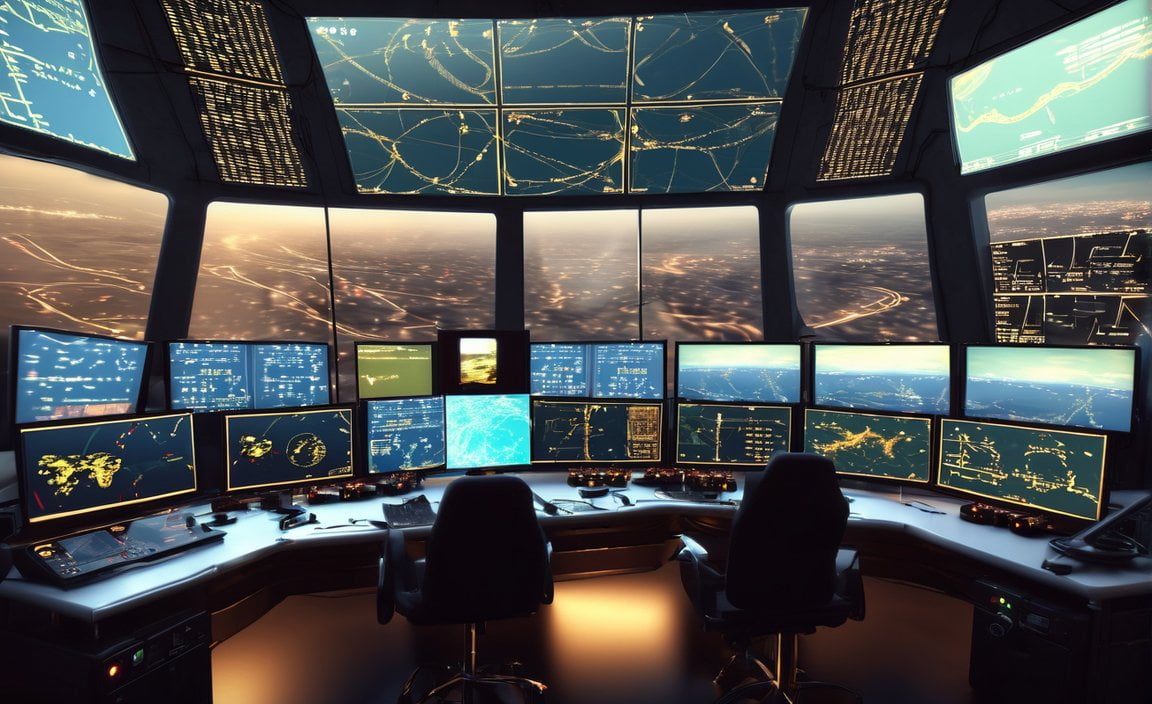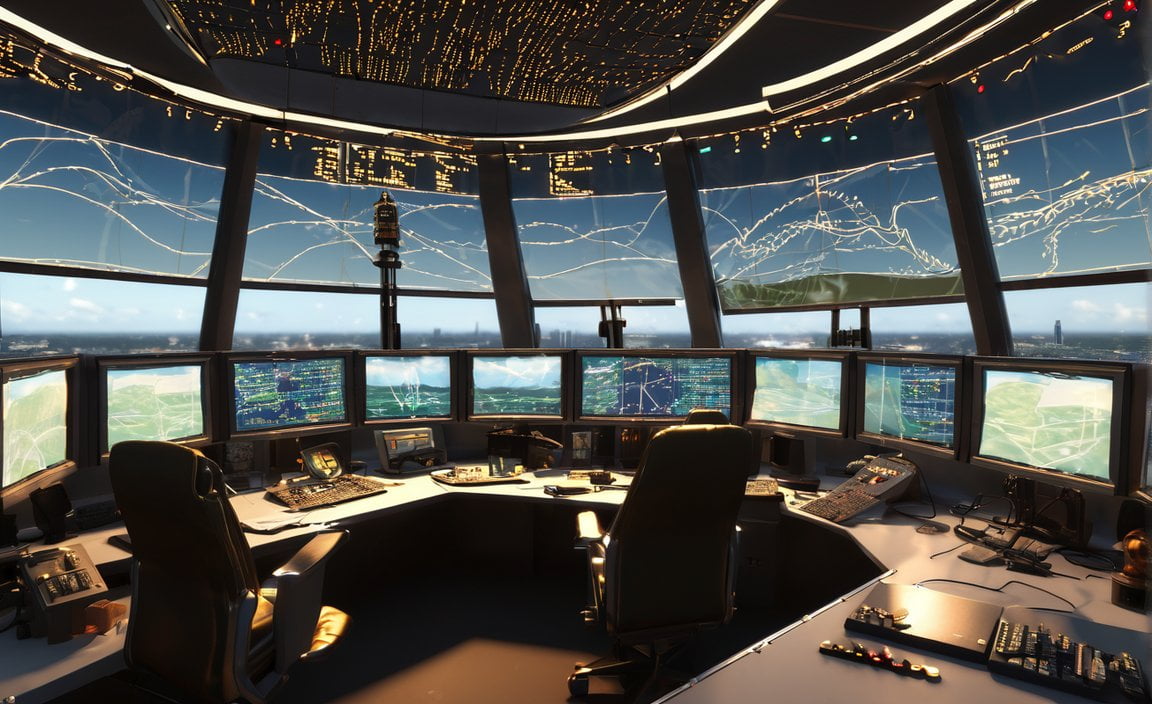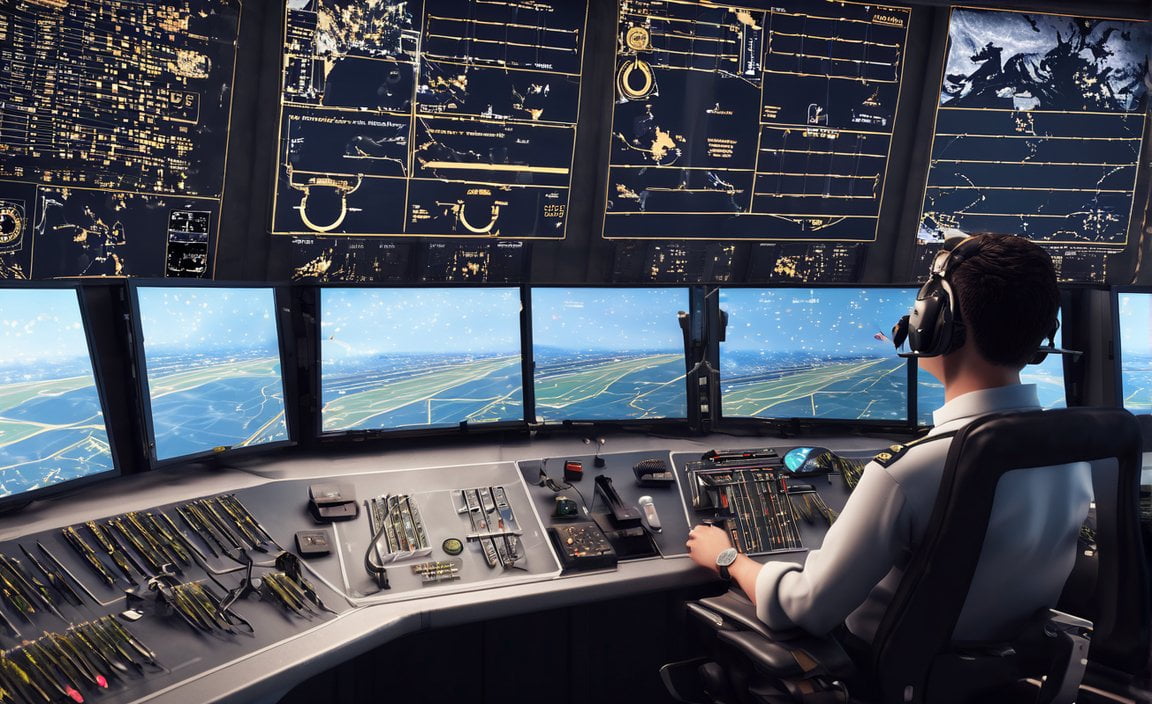Get ready to soar through the world of air traffic control systems as we delve into the advantages and disadvantages of these crucial systems. With the guidance of a seasoned aviation professional, we will explore the intricacies of managing airspace, ensuring the safety and efficiency of countless flights. Gain insights from an expert who has navigated the complex web of aviation regulations and technological advancements, as we analyze the pros and cons of air traffic control systems in this comprehensive examination. So fasten your seatbelts and prepare for an objective and insightful understanding of this vital aspect of the aviation industry.
Key Takeaways:
Advantages of Air Traffic Control System:
1. Ensures safe airplane journeys by monitoring and managing flight traffic.
2. Manages flight traffic efficiently, resulting in smoother operations and reduced delays.
3. Reduces flight delays by coordinating the movement of aircraft.
Disadvantages of Air Traffic Control System:
1. Air traffic control is a high-stress profession, putting controllers under significant pressure.
2. There is potential for human error as controllers make critical decisions and must remain vigilant.
Skills and Coping Mechanisms:
– Air traffic controllers require strong communication and critical thinking skills to coordinate with pilots effectively.
– Effective communication is crucial for airline safety and avoiding emergencies.
– Air traffic controllers undergo rigorous training to cope with high-stress situations and handle emergencies efficiently.
Relevant sources:
1. Aspiring Youths – Advantages and Disadvantages of Air Traffic Control System
2. Indeed – Pros and Cons of Being an Air Traffic Controller
Advantages and Disadvantages of Air Traffic Control System

As an experienced air traffic controller, I have had the opportunity to witness firsthand the strengths and weaknesses of air traffic control systems. In this article, we’ll delve into the advantages and disadvantages of these systems, shedding light on their impact on aviation safety and efficiency.
Advantages:
Air traffic control systems offer several noteworthy advantages that contribute to the smooth operation of the aviation industry. Let’s explore some of these key benefits:
Ensures safe airplane journeys: One of the paramount advantages of air traffic control systems is their role in ensuring the safety of aircraft and passengers. By monitoring and managing flight traffic, these systems play a crucial role in preventing collisions and maintaining a secure airspace.
Manages flight traffic efficiently: Air traffic controllers are responsible for efficiently managing the flow of air traffic. Through their expertise, they coordinate the movements of aircraft, ensuring a steady and seamless operation. As a result, flights are able to reach their destinations on time, minimizing delays and improving overall efficiency.
Reduces flight delays: Air traffic control systems act as guardians of efficiency in the aviation industry. By effectively coordinating the movement of aircraft, these systems help to minimize flight delays. They optimize routes, assign appropriate arrival and departure slots, and enable smooth transitions at airports, ultimately enhancing the punctuality and reliability of flights.
Disadvantages:
While air traffic control systems offer substantial advantages, there are certain challenges and drawbacks that accompany this vital profession. Let’s delve into some of the disadvantages:
High stress job for controllers: Air traffic control is undoubtedly a high-stress profession. Controllers have the responsibility to make split-second decisions and remain vigilant at all times. The demanding nature of the job, coupled with the need for unwavering focus, can lead to heightened stress levels and potential burnout.
Potential for human error: Human error is an inherent concern in air traffic control. Given the critical decisions that controllers have to make, there is always the potential for mistakes. Maintaining constant vigilance, adhering to procedures, and effective communication are essential to minimize the risks associated with human error.
Skills and Coping Mechanisms:
To effectively manage the challenges and excel in their roles, air traffic controllers must possess specific skills and coping mechanisms:
Strong communication and critical thinking skills: Communication lies at the core of successful air traffic control. Controllers need to communicate effectively with pilots, providing clear instructions and guidance. Additionally, critical thinking skills allow them to analyze complex scenarios quickly and make efficient decisions.
Rigorous training: To cope with the high-stress nature of their job, air traffic controllers undergo extensive training programs. These programs focus on simulating realistic scenarios to enhance controllers’ ability to handle emergencies effectively.
Conclusion:
Air traffic control systems offer significant advantages in terms of ensuring the safety, efficiency, and punctuality of air travel. However, it’s crucial to recognize the challenges and potential areas of improvement within this profession. By continuously enhancing training programs, incorporating advanced technologies, and nurturing a supportive working environment, the aviation industry can strive towards improved air traffic control systems.
References:
1. Aspiring Youths – Advantages and Disadvantages of Air Traffic Control System
2. Indeed – Pros and Cons of Being an Air Traffic Controller
Check out the advantages and disadvantages of air freight. Discover the pros and cons of using air transport for your shipping needs. Advantages and Disadvantages of Air Freight
Explore the advantages and disadvantages of air transport, and understand if it is the right choice for your transportation requirements. Advantages and Disadvantages of Air Transport
Disadvantages of Air Traffic Control Systems for Airspace Capacity

Air traffic control (ATC) systems play a vital role in ensuring safety and efficiency within the aviation industry. While there are numerous benefits to these systems, it is important to also consider the potential disadvantages, particularly in relation to airspace capacity. Let’s examine some of the key drawbacks:
Limited Airspace Capacity: One of the main disadvantages of air traffic control systems for airspace capacity revolves around the limited availability of airspace. The increasing demand for air travel has put a strain on existing airspace, leading to congestion and reduced capacity for incoming and outgoing flights. This limitation can result in delays, longer flight routes, and overall inefficiencies in the air traffic management system.
Complex Regulations: Another challenge that air traffic control systems face in relation to airspace capacity is the complexity of regulatory frameworks. The aviation industry is governed by a multitude of regulations and procedures that aim to ensure safety and efficiency. However, navigating these regulations and obtaining necessary clearance for flight operations can be time-consuming and cumbersome, contributing to airspace constraints.
Management of Airspace Classes: Airspace is divided into different classes, each with its own set of restrictions and requirements. It can be challenging for air traffic control systems to effectively manage the various airspace classes and accommodate diverse types of aircraft operations. This can result in limited flexibility and hinder the efficient utilization of airspace capacity.
Potential for Bottlenecks: As air traffic control systems aim to maintain safety and order in the skies, there is a risk of creating bottlenecks within the airspace. Restrictions imposed on specific routes or altitudes to prevent collisions and ensure separation between aircraft can lead to congestion in certain areas. These bottlenecks can further strain airspace capacity and result in delays for aircraft.
Dependency on Human Factors: Despite advancements in automation and technology, air traffic control systems still rely heavily on human operators. Factors such as fatigue, stress, and human error can have a significant impact on the efficiency and capacity of these systems. If not adequately addressed, these human factors can limit the effectiveness of air traffic control in managing airspace capacity.
In conclusion, while air traffic control systems provide numerous benefits to the aviation industry, there are several disadvantages that need to be considered in relation to airspace capacity. The limited availability of airspace, complex regulations, management of airspace classes, potential bottlenecks, and dependency on human factors all contribute to the challenges faced by air traffic control in optimizing airspace capacity.
Key Takeaways:
– Air traffic control systems face challenges in managing airspace capacity due to limited availability and increasing demand.
– Complex regulatory frameworks can contribute to constraints on airspace capacity.
– The management of different airspace classes can hinder the efficient utilization of airspace.
– Bottlenecks can occur within the airspace due to safety measures and separation requirements.
– Human factors such as fatigue and stress can impact the capacity and efficiency of air traffic control systems.
Sources:
– Ablison: Pros and Cons of Air Traffic Control 2023
– AspiringYouths: Advantages and Disadvantages of Air Traffic Control System
Impact of Technological Advancements on Air Traffic Control Systems
Air traffic control (ATC) systems play a crucial role in ensuring the safety and efficiency of air travel. With the continuous advancements in technology, these systems have undergone significant changes. In this article, we will explore the impact of technological advancements on air traffic control systems, examining both the benefits and drawbacks of these developments.
Enhanced Safety Measures and Collision Prevention
The integration of technological advancements in air traffic control systems has greatly enhanced safety measures and collision prevention capabilities. [Impact of technological advancements on air traffic control systems] has enabled more precise tracking of aircraft movements, allowing controllers to closely monitor aircraft and detect potential conflicts or deviations from designated flight paths with greater accuracy.
Additionally, advanced radar, surveillance systems, and communication technologies have improved coordination between air traffic controllers and pilots. Enhanced communication channels and real-time data exchanges help prevent collisions by providing timely warnings and route adjustments.
Streamlined Airspace Management
The implementation of [Impact of technological advancements on air traffic control systems] has revolutionized airspace management. Advanced automation and data processing capabilities have enabled more efficient allocation of airspace, resulting in reduced congestion and optimized aircraft flow.
With the help of sophisticated algorithms and predictive modeling, air traffic control systems can determine the most efficient routes for flights, taking into account various variables such as weather conditions and flight schedules. This streamlines operations, reduces the risk of delays, and improves overall airspace management.
Automation and Operational Efficiency
Technological advancements have led to increased automation in air traffic control systems. Automated systems can handle routine tasks, such as monitoring aircraft trajectories and adjusting flight routes, with improved accuracy and efficiency. This allows air traffic controllers to focus on more complex decision-making processes and critical situations.
Automated systems also help reduce human error, which can have significant consequences in air traffic control operations. By leveraging technological advancements, air traffic control systems can minimize the risk of miscommunication, misunderstandings, and manual calculation errors.
Challenges of Technological Advancements
While technological advancements have brought numerous benefits to air traffic control systems, they also present some challenges. The overreliance on automation raises concerns about the potential vulnerability of systems to cyber attacks and technical failures. Safeguarding these systems and ensuring their resilience against emerging threats is of paramount importance.
Furthermore, as air traffic control systems become more complex, air traffic controllers must continually upgrade their skills to adapt to changing technologies. Training programs and educational initiatives should keep pace with technological advancements to ensure controllers possess the necessary expertise and competencies.
Key Takeaways:
- Technological advancements have significantly impacted air traffic control systems, enhancing safety, efficiency, and operational effectiveness.
- [Impact of technological advancements on air traffic control systems] has improved collision prevention capabilities, streamlined airspace management, and increased automation, minimizing human error.
- However, challenges such as cybersecurity risks and the need for continuous training and skill upgrades must be addressed to ensure the successful integration of technological advancements in air traffic control systems.
Sources:
- Ablison. “Pros and Cons of Air Traffic Control 2023.” Ablison. Source
- ScienceDirect. “Threat impact analysis to air traffic control systems through flight.” ScienceDirect. Source
Considerations for the Future of Air Traffic Control Systems
Air traffic control (ATC) systems play a crucial role in ensuring the safety and efficiency of air travel. As the aviation industry evolves, it’s important to consider the future of these systems and the potential advancements and challenges they may face. Here are some key considerations to keep in mind:
Emerging Technologies and Automation
With the rapid advancement of technology, the future of air traffic control will likely involve increased automation and the integration of new technologies. [Considerations for the future of air traffic control systems] include exploring the benefits and challenges of incorporating technologies such as artificial intelligence (AI), machine learning, and unmanned aircraft systems (UAS). These innovations have the potential to enhance safety, improve efficiency, and optimize airspace management.
Cybersecurity and System Resilience
As air traffic control systems become more reliant on technology, there is a growing need to address cybersecurity concerns and ensure the resilience of these systems against potential threats. [Considerations for the future of air traffic control systems] include developing robust cybersecurity measures, implementing secure communication protocols, and regularly updating and patching system vulnerabilities. A secure and resilient air traffic control system is essential for maintaining the integrity and safety of air travel.
Human Factors and Training
While automation and technology advancements can bring significant benefits to air traffic control, the role of human operators remains crucial. [Considerations for the future of air traffic control systems] should include comprehensive training programs that simulate realistic scenarios and equip air traffic controllers with the necessary skills to handle emergencies effectively. Additionally, creating a supportive working environment and addressing potential challenges like stress and fatigue are essential for maintaining the well-being and performance of ATC personnel.
Collaboration and International Standards
The future of air traffic control systems requires increased collaboration and the establishment of international standards. As air travel becomes more globalized, it is crucial to develop harmonized procedures and protocols that facilitate seamless coordination between different air navigation service providers. [Considerations for the future of air traffic control systems] should include promoting collaboration, information sharing, and the development of common systems to ensure the efficient and safe movement of aircraft across borders.
Integration with Unmanned Aircraft Systems (UAS)
The rise of unmanned aircraft systems (UAS), commonly known as drones, presents new challenges and opportunities for air traffic control. As the number of commercial and recreational drones increases, integrating UAS into existing air traffic management systems becomes essential. [Considerations for the future of air traffic control systems] involve developing regulations, technology solutions, and communication protocols to safely manage the growing presence of UAS in the airspace.
Environmental Considerations and Sustainable Practices
With the increasing focus on sustainability, the future of air traffic control systems should also take into account environmental considerations. [Considerations for the future of air traffic control systems] include optimizing flight routes to minimize fuel consumption, exploring alternative fuels, and adopting eco-friendly practices to reduce the carbon footprint of air travel.
Key Takeaways:
- The future of air traffic control systems involves the integration of emerging technologies such as AI and UAS.
- Addressing cybersecurity concerns and ensuring system resilience is crucial for the future of ATC.
- Comprehensive training programs and a supportive working environment are essential for ATC personnel.
- Collaboration and international standards are necessary to facilitate seamless coordination between air navigation service providers.
- Integrating unmanned aircraft systems (drones) into existing ATC systems requires regulations and technology solutions.
- Environmental considerations and sustainable practices should be part of the future of air traffic control systems.
Sources:
FAQ
Q1: What is the role of air traffic control in ensuring safe airplane journeys?
A1: Air traffic control systems play a crucial role in ensuring the safety of aircraft and passengers by monitoring and managing flight traffic.
Q2: How does air traffic control contribute to efficient management of flight traffic?
A2: Air traffic controllers efficiently manage the flow of air traffic, ensuring smooth operations and minimizing delays.
Q3: What are the advantages of air traffic control in reducing flight delays?
A3: By coordinating the movement of aircraft, air traffic control systems help reduce flight delays and improve overall efficiency.
Q4: What are the challenges faced by air traffic controllers in their high-stress job?
A4: Air traffic control is a high-stress profession, as controllers must make quick decisions and remain alert at all times.
Q5: What are the potential risks associated with human error in air traffic control?
A5: Human error is a concern in air traffic control, as controllers are responsible for making critical decisions and maintaining constant vigilance.
- Crypto Quotes’ Red Flags: Avoid Costly Mistakes - June 30, 2025
- Unlock Inspirational Crypto Quotes: Future Predictions - June 30, 2025
- Famous Bitcoin Quotes: A Deep Dive into Crypto’s History - June 30, 2025
















